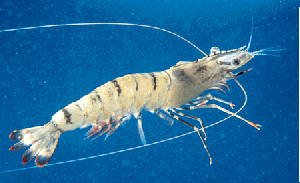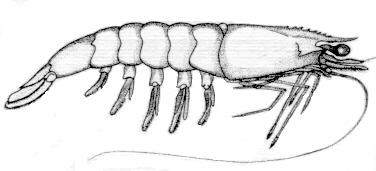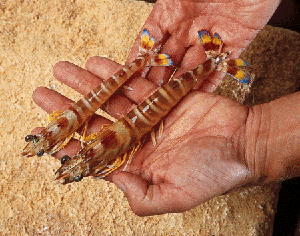
Hundreds of species of shrimp inhabit the brackish and marine waters of the globe. Most are rare, very small, or not suitable for human consumption. Cultured shrimp and most of the shrimp caught by fishermen belong to the Penaeidae family of crustaceans and are referred to as "penaeid shrimp". Some of the cultured species of the genus Penaeus are listed below.
Giant Tiger Shrimp (Penaeus monodon): Named for its huge size and banded tail, this species dominates production everywhere in Asia except Japan and China. Native to the Indian Ocean and the southwestern Pacific Ocean from Japan to Australia, "tigers" are the largest (maximum length 363 millimeters) and fastest growing of the farmed shrimp. They tolerate a wide range of salinities. Captive breeding is difficult and hatchery survivals are low (20 to 30%). Tigers are very susceptible to two of the most lethal shrimp viruses: yellow head and white spot. Consumers in Japan and the United States purchase huge quantities of tigers from Thailand and other countries in Southeast Asia.

Indian White Shrimp: Penaeus indicus is cultured on extensive farms throughout Southeast Asia. They have attracted attention recently because they tolerate low water quality better than P.monodon, they can be grown at high densities, and they are readily available in the wild. Unlike many of the penaeids, P.indicus regularly reaches sexual maturity in grow out ponds.
Native to the Indian Ocean from southern Africa to northern Australia and to Southeast Asia from the Philippines to eastern Australia, P.indicus is one of the major wild-caught species. It is the most important species caught off the east coast of Africa and is probably the most important commercial species in India, especially in the inshore fishery and in the rice field farming around Kerala.
Western White Shrimp (Penaeus vannamei): Native to the Pacific coast of South America and Central America (from Peru to Mexico). This is the leading cultured species in Ecuador and everywhere else in Latin America. White shrimp can be stocked at small sizes and have a uniform growth rate, reaching a maximum length of 230 millimeters. They breed in captivity better than P. monodon, but not as readily as P.chinensis and P.japonicus. Hatchery survivals are high, from 50 to 60%. Throughout Latin America, there are captive stocks of P.vannamei brood-stock, some of them pathogen-free and some of them pathogen-resistant.

Markets include the United States (60%), which takes raw, frozen, shell-on tails and value-added products and Europe (30%), which takes whole, frozen animals. Japan and China are the newest markets for western white shrimp.
Western Blue Shrimp (Penaeus stylirostris): Native to the Pacific coast of South America and Central America (from Peru to Mexico), western blue shrimp were a popular farmed species in the western hemisphere until the late 1980s when the IHHN virus attacked them, but not P.vannamei. Fortunately, captive stocks of P.stylirostris were maintained at several locations around the world. Through selective breeding, these stocks developed resistance to the IHHN virus.
From 1992 to 1997, when P.vannamei stocks everywhere in the western hemisphere were being devastated by the Taura virus, shrimp farmers took a second look at "stylies" and found that some of the captive stocks were resistant to IHHN and Taura! Consequently, in 1997, stylies made a strong comeback on farms throughout the western hemisphere, but especially Mexico. Fast growers, stylies look a lot like P.vannamei and have similar cultural requirements. They tolerate lower water temperatures than P.vannamei, but prefer higher oxygen levels, turbidity, salinities and protein levels. Stylies are aggressive feeders and will roam around the pond looking for feed. They like deep ponds and high water quality. Shipment of stylies brood-stock and seed stock is difficult, and stylies are more intent on escaping from ponds than P.vannamei.
From the consumer's point of view, P.stylirostris and P.vannamei are nearly identical, and they are frequently mixed together and sold as western white shrimp.
Chinese White Shrimp (Penaeus chinensis, also known as P. orientalis): Native to the coast of China and the west coast of the Korean peninsula, Chinese white shrimp grow at lower water temperatures (down to 16 degrees Celsius) than P.vannamei and P.monodon, tolerate muddy bottoms and very low salinities-and, of all the farmed species, they are the only one that readily mature and spawn in ponds. On the negative side, they have a high protein requirement (40 to 60%), a small size (maximum length of 183 millimeters), and a meat yield (56%) that is less than P.vannamei (63%) and P.monodon (61%). During the boom years of Chinese shrimp farming (1988-1993), they were marketed in the United States and around the world. Now most of the crop is consumed in China.
Japanese Kuruma Shrimp (Penaeus japonicus): Native to the Indian Ocean and the Southwestern Pacific Ocean from Japan to Australia, kuruma shrimp are farmed in Japan and Australia. Live kuruma shrimp bring outrageously high prices in Japan, as high as $100 a pound! It's easy to ship live animals, they mature and spawn in ponds, and they continue growing at lower water temperatures than any other farmed species, down to 10 degrees Celsius. They require clean, sandy bottoms and high protein diets (52 to 60%). Markets are limited to Japan.

Other Important Species: Penaeus merguiensis is native to the Indian Ocean from Oman to western Australia and to Southeast Asia from the Philippines to eastern Australia. P.merguiensis is heavily fished throughout its range, especially in Australia.
Source: Shrimp News International
Photo: CSIRO, Australia & Univ. of Arizona.
| Home |